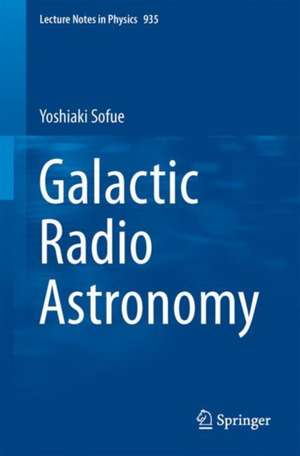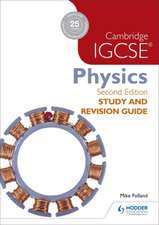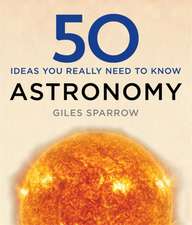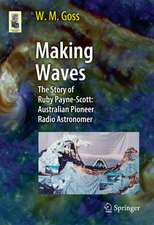Galactic Radio Astronomy: Lecture Notes in Physics, cartea 935
Autor Yoshiaki Sofueen Limba Engleză Paperback – 6 iun 2017
The book begins with the fundamental physics of radio-wave radiation, i.e., black body radiation, thermal emission, synchrotron radiation, and HI and molecular line emissions. The author then gives overviews of ingredients of galactic physics, including interstellar matter such as the neutral (HI), molecular hydrogen, and ionized gases, as well as magnetic fields in galaxies. In addition, more advanced topics relevant to the Galaxy and galaxies are also contained here: star formation, supernova remnants, the Galactic Center and black holes, galactic dynamics and dark-matter halos, magnetism of galaxies, interstellar gases in galaxies, and starbursts.
A unique feature of this book is its focus on how to analyze and interpret radio astronomical observation data and how to describe the underlying physics from such data. A wealth of figures and images will be a great help for undergraduate and graduate students to understand the contents. Furthermore, the well-summarized contents of theory and observation will appeal to young researchers as well.
Din seria Lecture Notes in Physics
- 19%
 Preț: 423.99 lei
Preț: 423.99 lei - 17%
 Preț: 360.73 lei
Preț: 360.73 lei -
 Preț: 429.22 lei
Preț: 429.22 lei - 17%
 Preț: 427.62 lei
Preț: 427.62 lei - 17%
 Preț: 460.25 lei
Preț: 460.25 lei -
 Preț: 427.96 lei
Preț: 427.96 lei -
 Preț: 481.93 lei
Preț: 481.93 lei - 17%
 Preț: 494.64 lei
Preț: 494.64 lei -
 Preț: 281.90 lei
Preț: 281.90 lei - 17%
 Preț: 493.20 lei
Preț: 493.20 lei - 17%
 Preț: 426.72 lei
Preț: 426.72 lei -
 Preț: 365.15 lei
Preț: 365.15 lei -
 Preț: 374.52 lei
Preț: 374.52 lei -
 Preț: 407.98 lei
Preț: 407.98 lei - 20%
 Preț: 428.12 lei
Preț: 428.12 lei -
 Preț: 263.30 lei
Preț: 263.30 lei - 15%
 Preț: 593.73 lei
Preț: 593.73 lei - 15%
 Preț: 528.13 lei
Preț: 528.13 lei -
 Preț: 493.12 lei
Preț: 493.12 lei - 17%
 Preț: 425.68 lei
Preț: 425.68 lei -
 Preț: 280.65 lei
Preț: 280.65 lei -
 Preț: 163.41 lei
Preț: 163.41 lei - 18%
 Preț: 726.59 lei
Preț: 726.59 lei -
 Preț: 394.84 lei
Preț: 394.84 lei - 15%
 Preț: 709.63 lei
Preț: 709.63 lei - 15%
 Preț: 623.90 lei
Preț: 623.90 lei - 20%
 Preț: 476.91 lei
Preț: 476.91 lei - 15%
 Preț: 428.05 lei
Preț: 428.05 lei -
 Preț: 342.78 lei
Preț: 342.78 lei - 18%
 Preț: 851.93 lei
Preț: 851.93 lei -
 Preț: 346.61 lei
Preț: 346.61 lei -
 Preț: 391.57 lei
Preț: 391.57 lei - 15%
 Preț: 633.16 lei
Preț: 633.16 lei -
 Preț: 451.71 lei
Preț: 451.71 lei - 5%
 Preț: 1497.80 lei
Preț: 1497.80 lei -
 Preț: 374.85 lei
Preț: 374.85 lei -
 Preț: 380.07 lei
Preț: 380.07 lei - 15%
 Preț: 516.14 lei
Preț: 516.14 lei - 15%
 Preț: 583.78 lei
Preț: 583.78 lei - 15%
 Preț: 508.60 lei
Preț: 508.60 lei -
 Preț: 469.71 lei
Preț: 469.71 lei -
 Preț: 388.90 lei
Preț: 388.90 lei - 15%
 Preț: 500.24 lei
Preț: 500.24 lei -
 Preț: 386.52 lei
Preț: 386.52 lei - 15%
 Preț: 472.88 lei
Preț: 472.88 lei -
 Preț: 424.27 lei
Preț: 424.27 lei -
 Preț: 380.07 lei
Preț: 380.07 lei - 15%
 Preț: 500.01 lei
Preț: 500.01 lei
Preț: 453.87 lei
Preț vechi: 567.35 lei
-20% Nou
Puncte Express: 681
Preț estimativ în valută:
86.86€ • 90.17$ • 72.43£
86.86€ • 90.17$ • 72.43£
Carte tipărită la comandă
Livrare economică 21-27 martie
Preluare comenzi: 021 569.72.76
Specificații
ISBN-13: 9789811034442
ISBN-10: 9811034443
Pagini: 229
Ilustrații: XVIII, 229 p. 135 illus., 44 illus. in color.
Dimensiuni: 155 x 235 mm
Greutate: 0.41 kg
Ediția:1st ed. 2017
Editura: Springer Nature Singapore
Colecția Springer
Seria Lecture Notes in Physics
Locul publicării:Singapore, Singapore
ISBN-10: 9811034443
Pagini: 229
Ilustrații: XVIII, 229 p. 135 illus., 44 illus. in color.
Dimensiuni: 155 x 235 mm
Greutate: 0.41 kg
Ediția:1st ed. 2017
Editura: Springer Nature Singapore
Colecția Springer
Seria Lecture Notes in Physics
Locul publicării:Singapore, Singapore
Cuprins
Introduction.- Interstellar Matter.- Star Formation and Death.- Galactic Structure.- The Galactic Center and Activity.- Nonthermal Emission and Magnetic Fields.
Notă biografică
Yoshiaki Sofue works on theoretical aspects of radio astronomy, galactic astrophysics, galactic dynamics, and interstellar physics. In particular, he focuses on galaxies (specifically the Milky Way Galaxy), galactic center, and interstellar matter.
Prof. Sofue received his Ph.D. at the Department of Astronomy, The University of Tokyo, in 1973. Between 1968 and 1982 he was a research associate at Nagoya University, the Department of Physics. Between 1982 and 1987 he was an associate professor at the Nobeyama Radio Observatory, The University of Tokyo, and at the Department of Astronomy, The University of Tokyo, between 1987 and 1988. Between 1988 and 2006 he was a full professor at the Institute of Astronomy, The University of Tokyo. During that period he was appointed the Director of the Institute of Astronomy and the Director of Kiso Observatory. In 2006 he became an emeritus professor at The University of Tokyo and in 2007 joined the Department of Physics and Astronomy, Kagoshima University and the Department of Physics, Astronomy Laboratory at Meisei University between 2010 and 2013 as a professor, respectively. From 1976, he frequently joined the Max-Planck-Institute für Radioastronomie as an Alexander von Humboldt fellow, and, notably, was also supported by a Feodor Lynen Research Fellowship in 2007.
Prof. Sofue has served as a member of the Science Council of Japan, and also has contributed to the Astronomical Society of Japan (ASJ) as an Executive Committee member, Council member, Vice President, and President. He was an editor of the Publications of the Astronomical Society of Japan. He joined the Organizing Committee of Division VI of the International Astronomical Union and is currently a member of the International Astronomical Union.
Prof. Sofue received his Ph.D. at the Department of Astronomy, The University of Tokyo, in 1973. Between 1968 and 1982 he was a research associate at Nagoya University, the Department of Physics. Between 1982 and 1987 he was an associate professor at the Nobeyama Radio Observatory, The University of Tokyo, and at the Department of Astronomy, The University of Tokyo, between 1987 and 1988. Between 1988 and 2006 he was a full professor at the Institute of Astronomy, The University of Tokyo. During that period he was appointed the Director of the Institute of Astronomy and the Director of Kiso Observatory. In 2006 he became an emeritus professor at The University of Tokyo and in 2007 joined the Department of Physics and Astronomy, Kagoshima University and the Department of Physics, Astronomy Laboratory at Meisei University between 2010 and 2013 as a professor, respectively. From 1976, he frequently joined the Max-Planck-Institute für Radioastronomie as an Alexander von Humboldt fellow, and, notably, was also supported by a Feodor Lynen Research Fellowship in 2007.
Prof. Sofue has served as a member of the Science Council of Japan, and also has contributed to the Astronomical Society of Japan (ASJ) as an Executive Committee member, Council member, Vice President, and President. He was an editor of the Publications of the Astronomical Society of Japan. He joined the Organizing Committee of Division VI of the International Astronomical Union and is currently a member of the International Astronomical Union.
Textul de pe ultima copertă
This book is a concise primer on galactic radio astronomy for undergraduate and graduate students, and provides wide coverage of galactic astronomy and astrophysics such as the physics of interstellar matter and the dynamics and structure of the Milky Way Galaxy and galaxies. Radio astronomy and its technological development have led to significant progress in galactic astronomy and contributed to understanding interstellar matter and galactic structures.
The book begins with the fundamental physics of radio-wave radiation, i.e., black body radiation, thermal emission, synchrotron radiation, and HI and molecular line emissions. The author then gives overviews of ingredients of galactic physics, including interstellar matter such as the neutral (HI), molecular hydrogen, and ionized gases, as well as magnetic fields in galaxies. In addition, more advanced topics relevant to the Galaxy and galaxies are also contained here: star formation, supernova remnants, the Galactic Center and black holes, galactic dynamics and dark-matter halos, magnetism of galaxies, interstellar gases in galaxies, and starbursts.
A unique feature of this book is its focus on how to analyze and interpret radio astronomical observation data and how to describe the underlying physics from such data. A wealth of figures and images will be a great help for undergraduate and graduate students to understand the contents. Furthermore, the well-summarized contents of theory and observation will appeal to young researchers as well.
Caracteristici
Describes the interstellar physics and dynamics of the Galaxy and external galaxies with its consideration for students Provides readers with knowledge of the underlying physics necessary to understand observed facts of interstellar phenomena, dynamics and dark matter, and central activities and black holes in the Galaxy and galaxies Includes a wealth of figures and illustrations to explain the described facts and considerations









